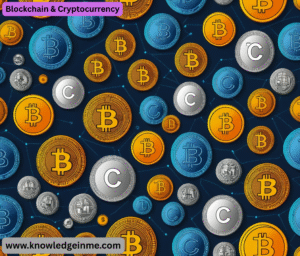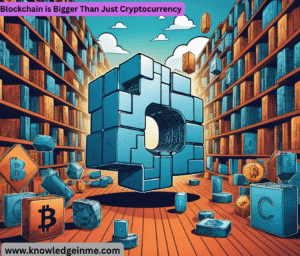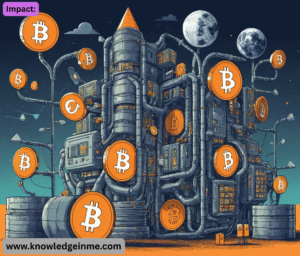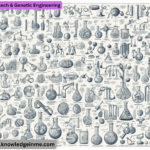Blockchain & Cryptocurrency Of course. Here is a comprehensive overview of Blockchain & Cryptocurrency, breaking down the concepts from fundamental principles to their broader implications.
The Core Concept: A Distributed Ledger
- At its heart, blockchain is a revolutionary type of database, often called a distributed ledger.
Imagine a Google Sheet that is:
- Decentralized: Instead of being stored on one company’s server (like Google’s), it’s copied and spread across thousands of computers worldwide.
- Immutable: Once data is entered, it becomes extremely difficult to change or delete it. It’s “write-once, append-many.”
- Transparent: Anyone can view the entire history of transactions, which are recorded in a public, verifiable way.
- This combination of features solves a classic problem in computer science: the Byzantine Generals’ Problem—how to achieve consensus and trust in a distributed network where some participants might be unreliable or malicious.
How Does a Blockchain Work? (The “Blocks” and “Chain”)
The name gives it away.
- Transaction: Someone requests a transaction (e.g., “Send 5 Bitcoin from Alice to Bob”).
- Broadcast: That transaction is broadcast to a peer-to-peer (P2P) network of computers, known as nodes.
- Validation: The network of nodes validates the transaction using known algorithms. They check things like: Does Alice have the 5 BTC to send?
- Block Creation: Once validated, the transaction is combined with other pending transactions to form a new block. This block
- also contains a unique code called a hash and the hash of the previous block in the chain.
- This process of validating transactions and creating new blocks is called mining or staking, depending on the consensus mechanism the blockchain uses.
Examples:
- Bitcoin (BTC): The first and most famous cryptocurrency, created by the pseudonymous Satoshi Nakamoto. Its primary goal is to be a decentralized digital currency and “digital gold.”
- Ethereum (ETH): More than just a currency, Ethereum is a decentralized computing platform.
Blockchain is Bigger Than Just Cryptocurrency
- While cryptocurrency was the first “killer app” for blockchain, the technology itself has countless other applications. These are often referred to as Web3 or decentralized technology.
- Decentralized Finance (DeFi): Recreating traditional financial systems (lending, borrowing, insurance, trading) without intermediaries like banks, using smart contracts on blockchains like Ethereum.
- Non-Fungible Tokens (NFTs): Unique digital tokens on a blockchain that represent ownership of a specific item, whether it’s digital art, music, collectibles, or real-world assets.
- Supply Chain Management: Tracking the journey of products from origin to consumer with complete transparency and immutability (e.g., tracking the source of food or luxury goods).
- Digital Identity: Giving individuals control over their own digital identities and personal data, which can be verified without a central authority.
- Voting Systems: Creating a transparent and tamper-proof voting system to reduce fraud and increase trust in electoral processes.
Key Challenges and Criticisms
- Scalability: Many blockchains (like Bitcoin and Ethereum) struggle with processing a high number of transactions quickly and cheaply. This is known as the “blockchain trilemma” (balancing decentralization, security, and scalability).
- Energy Consumption: Proof-of-Work blockchains, particularly Bitcoin, consume vast amounts of electricity, leading to environmental concerns.
- Regulation & Volatility: The regulatory landscape is still evolving, creating uncertainty. Cryptocurrency prices are notoriously volatile.
- Complexity & User Experience: Using blockchain applications often requires managing private keys and understanding complex concepts, which can be a barrier to mainstream adoption.
- Illicit Activity: The pseudo-anonymous nature of some blockchains can facilitate illegal transactions (though cash is still the primary medium for illicit activity).
Beyond Bitcoin & Ethereum: The Layerscape
- Modern blockchain architecture is no longer just a single chain. It’s a complex ecosystem of layers designed to solve the core problem of scalability.
Layer 1 (L1): The Base Protocols
- These are the foundational blockchains themselves.
- Examples: Bitcoin, Ethereum, Solana, Avalanche, Cardano.
- The Trilemma: L1s constantly battle the “Blockchain Trilemma,” trying to achieve all three of: Decentralization, Security, and Scalability.
Layer 2 (L2): Scaling Solutions
- Rollups (for Ethereum): Bundling (or “rolling up”) transactions into a single one. Zero-Knowledge Rollups (ZK-Rollups) use advanced cryptography for validation, while Optimistic Rollups assume transactions are valid and only run computation in case of a challenge.
- Lightning Network (for Bitcoin): A network of payment channels that allows for instant, near-free Bitcoin transactions.
Sidechains
- They have their own consensus mechanisms and security models but can interoperate with the main chain.
- Example: Polygon PoS is a sidechain that bundles transactions and periodically “checkpoints” them to Ethereum.
- This multi-layer structure is creating a more complex and interoperable ecosystem.
Advanced Concepts: DAOs and The Merge
Decentralized Autonomous Organizations (DAOs)
- It operates based on rules encoded in smart contracts (its constitution) and uses treasury funds that require group approval to spend.
- How it works: Members hold governance tokens that allow them to vote on proposals (e.g., “Should we fund Project X?”).
- Significance: DAOs represent a new experiment in human coordination and governance, potentially redefining corporate structures.
The Merge (Ethereum’s Historic Upgrade)
- In September 2022, Ethereum successfully underwent “The Merge,” transitioning its consensus mechanism from Proof-of-Work (PoW) to Proof-of-Stake (PoS).
Impact:
- Blockchain & Cryptocurrency ~99.95% Reduction in Energy Consumption: This single change addressed the biggest criticism of Ethereum and drastically reduced its carbon footprint.
- Paved the Way for Future Scaling: The Merge was a necessary prerequisite for implementing the full suite of scaling solutions (like sharding) to make Ethereum faster and cheaper.
The Current Landscape: More Than Just Currency
The space has evolved into distinct, booming sectors:
- DeFi (Decentralized Finance) Summer & Beyond: DeFi has matured into a full-blown alternative financial system with lending protocols (Aave, Compound), decentralized exchanges (Uniswap, Curve), and derivatives markets. The key innovation is that these services are accessible to anyone with an internet connection and a crypto wallet, without needing to trust a bank.
- The NFT Evolution: NFTs have moved far beyond profile picture projects (like Bored Apes).
- Ticketing: Preventing fraud for concerts and events.
- Real-World Assets (RWA): Tokenizing real estate, fine art, or commodities on a blockchain to make them easier to fractionally own and trade.
- AI x Crypto Convergence: This is a major frontier.
- Create Decentralized AI Marketplaces: Where users can monetize their data or rent out computational power for AI training in a transparent way.
Deepened Challenges and Criticisms
- The Regulatory Onslaught: Governments worldwide are scrambling to regulate the space.
- Are cryptocurrencies securities or commodities? This classification dictates which agency regulates them and how.
- How to tax them? Clarity is improving but remains complex.
- How to prevent illicit finance without stifling innovation? The focus is on enforcing Know Your Customer (KYC) and Anti-Money Laundering (AML) rules on centralized exchanges.
- The Bridge Problem: While bridges between blockchains are crucial for interoperability, they have become the single biggest security vulnerability.
- The User Experience (UX) Chasm: For mass adoption, the UX must improve. Managing a 12-word seed phrase (your private key) is a daunting and irreversible point of failure for most non-technical users. Loss of the seed phrase means permanent, irrecoverable loss of funds.
- The reality often falls short of the ideal.
Looking Forward: The Next Cycle
The space moves in cycles of innovation, hype, crash, and building. The next major themes are likely to be:
- Full Realization of Modular Blockchains: Separating the functions of execution, consensus, and data availability into specialized layers for maximum efficiency.
- Mass Tokenization of Real-World Assets (RWA): Bringing trillions of dollars of traditional finance onto blockchain rails.
- Improved Privacy: Finding ways to incorporate privacy (e.g., through zero-knowledge proofs) into transparent blockchains for confidential transactions without sacrificing auditability.
- Account Abstraction: Radically simplifying the user experience by allowing smart contracts to control accounts, enabling features like social recovery of wallets and paying fees in any token.






